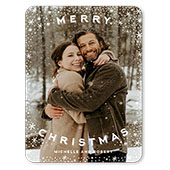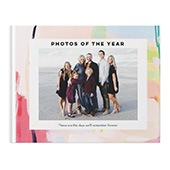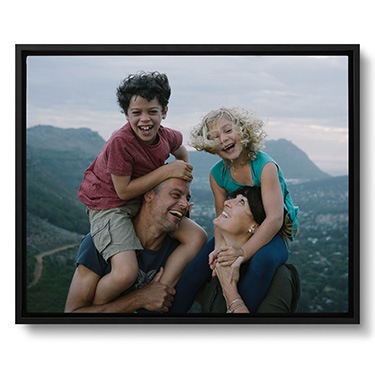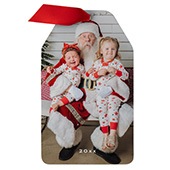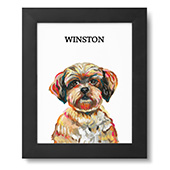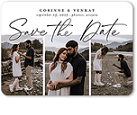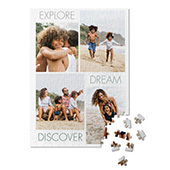You’ve designed and prepared your customized wedding invitations. Congratulations! You can now check off a major task on your wedding planning checklist.

If you’re still working on it, browse our wedding invitation wording etiquette guide with wording examples for couples hosting, parents hosting, adults-only affairs special wording, and guidelines for when to send your invitations.
Now it’s time to address and stamp the envelopes.
This guide to addressing your wedding invitation envelopes takes you through the four major considerations:
- Envelope Wording Examples for Single Guests, Couples and Plus-Ones
- Etiquette for the Return Address
- Stamp Etiquette
- Printed Labels and Hand-Written Wedding Invitation Addresses
Whether you use Shutterfly’s addressing and mailing service, print your own labels, print directly on the envelopes, or hire a professional calligrapher, it’s smart to follow proper etiquette when addressing wedding invitations.
Unlike an ordinary envelope, the wording on the wedding invitation envelope is influenced by a few factors:
- The guests
- The formality of the event
- Certain planning details
This guide will help you prepare the wording and select the proper stamp for your envelopes. You’ll also weigh the unique benefits of printed labels vs. handwritten addresses.
What you need: the master guest list for your wedding with proper names and addresses.
The Wedding Invitation Envelope
There are three parts to a wedding invitation envelope:
- The recipient: the name(s) and address of the guests you wish to invite
- The return address
- The stamp
The following examples show how to address your wedding invitation envelopes with etiquette and planning factors in mind.
The Recipient: Envelope Wording Examples for Single Guests, Couples and Plus-Ones
You’ve put a lot of thought into the final guest list for your wedding. Due to budget and space requirements, you might have had to narrow your list to adults only, or invite a limited number of people from each family. Don’t rely on the invitation to communicate this information.

As you finalize your guest list, remember that how you address your wedding invitation envelope will send a message about who is invited.
The recipient line of the envelope should include everyone who is invited to the wedding.
“It’s important to be very specific when addressing wedding invitations,” says Los Angeles-based wedding planner and designer Christine Zohrabians of Fancy That Events. “If children are invited, for example, the name of each child has to be included on the outside envelope as well as inside on the invitation.”
It’s also important to consider titles. Are you inviting a married couple? Do they have the same last names? Is the guest an unmarried female? Here are common examples of how to address wedding invitation envelopes according to the recipient.
To a single person:
Mr. Jones
73 Goodlett Pl
San Francisco, Ca 14002
If the guest is an unmarried female of any age, use the title “Ms.”
To a married couple:
Mr. and Mrs. Peter Jones
73 Goodlett Pl
San Francisco, Ca 14002
You only need the husband’s first name. If the husband and wife have different surnames, include the wife’s first name and title (Mrs.) first, or above the husband’s full name.
To a couple living together (unmarried):
Mr. Peter Jones and Ms. Stacey Marshall
73 Goodlett Pl
San Francisco, Ca 14002
Wedding invitation to a married couple with children:
Mr. and Mrs. Peter Jones
Owen and Julian
73 Goodlett Pl
San Francisco, Ca 14002
Children under the age of 18 should be listed by first name in order of their age. Girls under the age of 18 should be addressed as Miss. Children 18 and older should be sent their own invitations; boys 18 and older should be addressed as Mr.
Wedding invitation with a plus-one:
Mr. Jones and Guest
73 Goodlett Pl
San Francisco, Ca 14002
What about your friend’s boyfriend or girlfriend? They’re in a serious relationship, but you don’t know the person’s name or address. First, try to find out this information and send the plus-one their own invitation. If you don’t have the name and address of the date, you can write your friend’s “name and guest.”
Etiquette for the Return Address
Not just any return address will do. Consider the return address on the wedding invitation envelope as the final resting stop for all the acceptances and regrets.

Wherever your guests are coming from to join your wedding celebration, a properly addressed invitation envelope will dazzle and delight and set the scene for your coming nuptials.
The host is usually in charge of collecting the RSVP cards, but the responsibility might be allocated to a different family member or friend. This is a pretty big responsibility and proper count is key to finalizing the final guest list.
The wedding invitation return address should also be the place you want your wedding gifts to go. Do you want your gifts to be sent to your house, or your parent’s house?
While the final decision is up to you, discuss these options with your planning team and make sure the person who lives at the return address understands the joyful duties that come with helping you plan your wedding day.
The Stamp
The final piece to the wedding invitation envelope is the stamp. Before you purchase hundreds of stamps, weigh the entire wedding invitation suite. When you factor in response cards, enclosure cards, and reception cards, some invitations are heavier than others.
Once you have the proper postage, you can now find a stamp that complements your wedding invitations.
Look for an attractive design that’s appropriate for a marriage, such as hearts or flowers. You can also design personalized postage stamps that feature your photo, name or initials.
Time-saving tip! Shutterfly can stamp and mail any quantity of invitations directly to your recipients for an additional $0.99 domestic or $1.49 international per card.
The outside mailing envelope of your wedding invitation is like wrapping paper to a precious gift.
Inside, your guests will find a symbol of affection that invites them to join the festivities of your big day. It’s an exciting package to receive in the mail, one that reflects the significance of your marriage, your unique wedding style, and the formality of your event.
It’s no wonder traditional wedding etiquette calls for such high standards when it comes to the design and wording of the outside envelope.
Printed Labels and Hand-Written Wedding Invitation Addresses
When it comes to addressing wedding invitations, are you wondering whether labels or hand-written is preferred?
Up until recently, the only proper way to address wedding invitations was by hand.
Today, you have a few options for inscribing addresses on the envelopes — though the secret to pulling it off without downplaying the event lies in following some contemporary rules of etiquette.

You have a few options for inscribing addresses on the envelopes for your wedding invitations. You can create appropriate and stunning wedding invitation envelopes with printed labels from Shutterfly.
“Opt for custom printed labels or hire a professional calligrapher,” says Christine Zohrabians, wedding planner and designer of Fancy That Events. “While it might not be traditional to use printed labels, today’s custom labels look incredible and complete the invitation suite.”
In the examples above, you’ll see how different factors, including your guests, the formality of your event and certain planning details, affect how an envelope is addressed, with examples for various scenarios.
Here’s a look at the rules of etiquette that apply for addressing wedding invitation envelopes in handwriting or with printing technology, the pros and cons for each option, as well as some expert tips on how to handwrite your own addresses like a true artist.
Printed Address Labels for Wedding Invitations
Sure, tradition says hand-written addresses are the way to go; but not everyone has the time, budget, or talent to handwrite hundreds of addresses.
If you’re throwing a casual wedding, an extremely large wedding (200+ guests), or simply do not have the budget to hire a professional calligrapher, you can create appropriate and stunning printed labels for wedding invitation envelopes.
If you plan to use printed labels, Christine suggests going with a custom design that matches and completes your wedding invitation stationary set. Printed labels can save you time, money, and add a personal touch your guests will love.
Avoid printing address labels at home from your own computer. It looks tacky and is considered poor etiquette regardless of the formality of your wedding.
Remember, Shutterfly’s service for addressing and mailing wedding invitations to save you time and help you follow proper invitation etiquette if you’re still wondering how to address wedding invitations.

There is a perfect way to invite your guests to your wedding day — it’s with a personalized wedding invitation set that will arrive at your guests’ door like a precious gift.
Calligraphy and Tips for Faux Calligraphy
As mentioned above, hand-written addresses are the traditional way to inscribe your wedding envelopes. The work of a professional calligrapher is beautiful, flawless, and honors the special day to come.
If you have the budget, look for a local, trusted calligrapher — an experienced artist recommended by a friend or family member. A calligrapher is a great option for all types of weddings, from formal and traditional celebrations to casual weddings.
If you don’t have the budget to hire a professional calligrapher, you may still want the elegance and tradition that comes with hand-written addresses. If you fancy yourself as having fine penmanship, then with some time, patience, and grace for a few throw-away envelopes, you can do it yourself and still comply with the rules of etiquette. Here’s how:
Select the best candidate. Everyone knows at least one person with lovely handwriting. Call them, ask for their help. Ideally, this person is part of your wedding party, a family member, or friend.
Start early. Professional calligraphers usually want two to three weeks for the job, which means you or your helper will need the same if not more time to hand write your wedding envelopes.
Do the proper preparation work. Determine the proper wording for wedding invitations beforehand by following wedding etiquette guidelines. Provide your helper or yourself with a master list — one that’s been proofread, checked and rechecked.
Use the proper tools. Test a few calligraphy pens, gel pens, and markers to find one that glides easily on the type of envelope paper that you have. A pen that glides on the paper makes writing fast and easy. If you go with a gel pen, consider drying time to avoid smudging.
Consider style and spacing. Do you want to write in cursive, print or a combination? Can you fit the ZIP code on the same line as the city and state? The type of pen you use might also affect the size and spacing of the letters. Do a few searches for “faux calligraphy” to see the pros’ tips. For instance, you can create a lovely effect with the guests’ name in cursive and the address in print.
Practice. Don’t be afraid to throw away the first few envelopes. Even a helper with great handwriting will have to practice a few times before addressing your envelopes.
Say thank you. Acknowledge and thank your friend for their time and dedication with a personalized gift they will love.
Shutterfly Wedding Invitations and Envelope Services
There is a perfect way to invite your guests to your wedding day – it’s with a personalized wedding invitation set. Shutterfly lets you shop, design, and order your wedding invitation stationary, including the perfect envelopes that coordinate with your invitation, enclosure card and RSVP card collection.
Printed address labels are easy to customize with the font, style, and color palette you want. Shutterfly will stamp and mail invitations directly to your guests for an additional $0.99 domestic or $1.49 international per card.
Design a personalized wedding invitation envelope with Shutterfly. You can choose from a variety of designs, trims, and color palettes that coordinate with your wedding invitations. The best part? Shutterfly can address, stamp, and mail them for you. A bride-to-be has a lot on her plate, so take advantage of this concierge service.
5 Free Samples
Get five free samples you can touch and feel. The design possibilities are endless!
Speed up the decision process with five free wedding invitation samples featuring your details.
